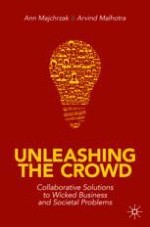
2020 | OriginalPaper | Buchkapitel
1. What Is Crowdsourcing for Innovation?
verfasst von : Ann Majchrzak, Arvind Malhotra
Erschienen in: Unleashing the Crowd
Aktivieren Sie unsere intelligente Suche, um passende Fachinhalte oder Patente zu finden.
Wählen Sie Textabschnitte aus um mit Künstlicher Intelligenz passenden Patente zu finden. powered by
Markieren Sie Textabschnitte, um KI-gestützt weitere passende Inhalte zu finden. powered by